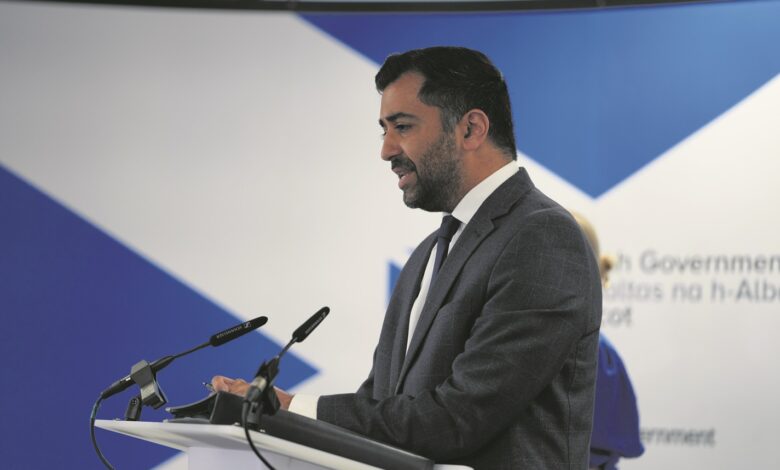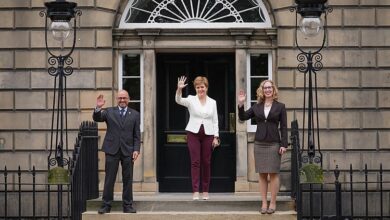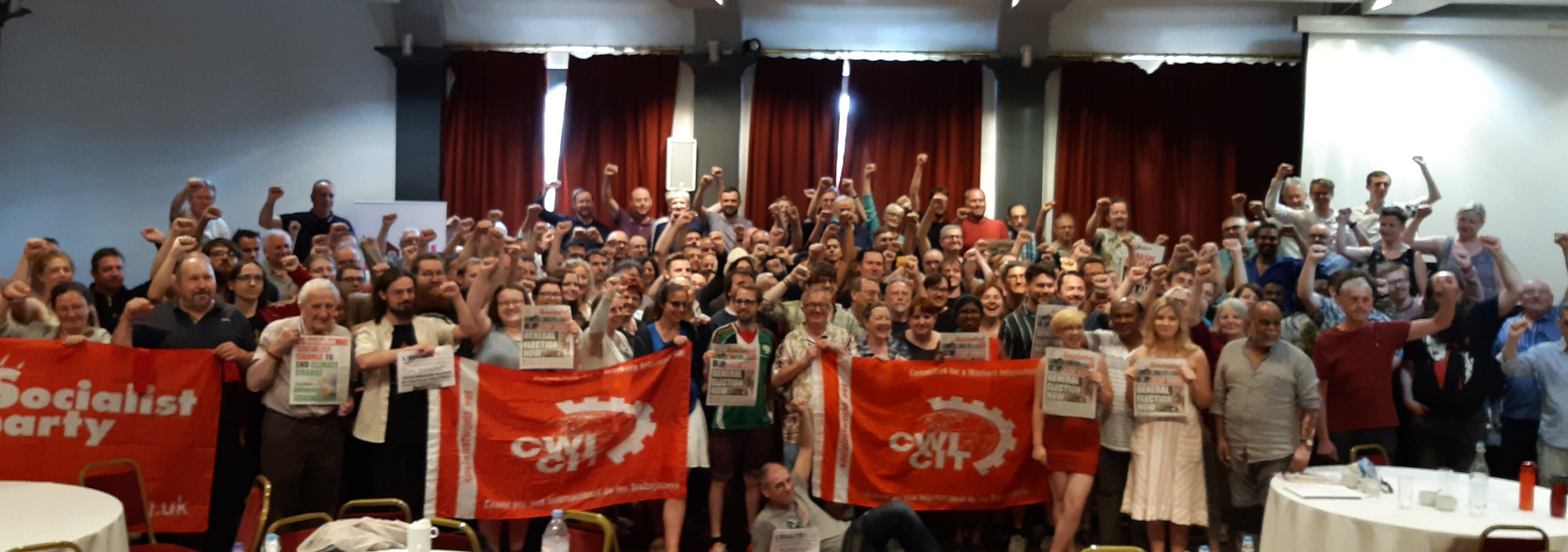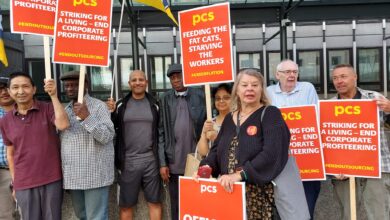The SNP in crisis one year on
Build a new workers' party with a socialist programme

Philip Stott
A year has passed since the SNP was thrown into a huge crisis following the resignation of Nicola Sturgeon as party leader and first minister. As we pointed out at the time: “The crisis facing the SNP is rooted in their implementation of austerity and anti-working class policies generally. The strike wave 2022/23 strike wave also played a decisive role in exposing and undermining Sturgeon’s government.”
The erosion of working-class support for an SNP leadership that had filled part of the vacuum that existed for a new mass workers’ party in Scotland over the last decade is an extremely important development.
It also completely confirms Socialist Party Scotland’s perspective put forward in 2014 – alone on the left – that the SNP’s pro-capitalist policies would prove to be their undoing.
The election of Humza Yousaf as first minister has done nothing to stop the rot. It is not even certain that Yousaf will lead the party into the general election.
Its not ruled out that Kate Forbes or some other alternative could replace Yousaf in the run-up to the election or immediately afterwards.
Current polling shows Labour poised to emerge as the biggest party in Scotland after the election. If this was to be the case it would most likely result in another leadership contest and another crisis.
The undermining of the electoral base of the SNP was underlined by an analysis by John Curtice, in January 2024, that found: “Whereas at the end of 2022 80 per cent of current yes supporters were saying that they would vote SNP in a UK general election, now that figure has fallen to a new low of just 63 per cent.”
Yousaf’s attempt to frame the general election in Scotland as a contest between the SNP and the Tories in Scotland is a desperate attempt to hold onto seats in the traditional areas of support for the nationalists – the rural and more middle class parts of Scotland.
They are likely to lose a large number of seats in the west of Scotland in particular to Labour. From being one of the moist successful capitalist governments in Europe – in power at Holyrood for seventeen years now – the chickens have now come home to roost for the SNP. Even a defeat at the 2026 Scottish parliament election is now possible.
The one factor that can limit the decline is the use of the national question to try and put a floor under the exodus of working-class support from the nationalists.
Support for independence has remained unaffected by the SNP crisis at around 50%. With Yousaf promising that “line one of the manifesto” will be vote SNP to deliver an independent Scotland, the hope is that can persuade enough pro-independence supporters to stick with the party at the general election.
The SNP MP Tommy Sheppard summed up this strategy and appeal to pro-indy supporters when he wrote: “We need to be very clear with the electorate, this year’s vote is about whether the journey continues, whether we can create circumstances to move towards our independence….If the SNP lose the election in Scotland, the debate on independence stops.”
With the Westminster election likely to be seen as a chance to be rid of the Tories, Scottish Labour under its neo-Blairite leadership is hoping to pick up the support of at least one fifth of the pro-independence voters. If they succeed, Scottish Labour could defeat the SNP.
However, in no way would this signify a ringing endorsement of Starmer or Sarwar. On the contrary, there is little to no enthusiasm or expectation that Labour will deliver for the working class. That’s why record levels of abstentionism, especially among independence supporting voters, is very likely to be a major feature of the election. Alongside a certain uptick in support for the Scottish Greens and Alba – this will be limited if it happens at all.
The mood of utter disregard for all the main parties was expressed in the Sunday Times poll at the end of January 2024 which found an overwhelming lack of trust for all the main party leaders.
The collapse in authority towards the SNP leadership was stark. Nicola Sturgeon’s trust levels stood at -19%, with Humza Yousaf on -25%. Keir Starmer was -24% and Anas Sarwar on -17%.
The lack of a mass working-class political alternative is one of the main issues that can only be overcome through the building of mass workers’ party with a socialist programme.
national question
The collapsing support for the SNP, which currently stands at just over 30%, is also linked to their utter failure to offer a viable fighting strategy on independence.
We have dealt in detail with this question over the years; in summary that the pro-capitalist SNP leadership has never had any intention of seeking to mobilise a mass movement to try to overcome the entrenched opposition of the capitalist class to the break-up of the UK.
This has led them into a quagmire following a series of retreats that followed the UK Supreme Court ruling that Holyrood did not have the competence to organise a referendum on independence.
Currently, the SNP leadership now say if they emerge as the biggest party in Scotland in terms of MPs, this will give them a mandate to negotiate with a Starmer government over the transfer of powers to Edinburgh to allow the Scottish government to organise indyref2 in the future.
Starmer has already made clear this will not happen under a Labour government. While support for independence has remained consistent, the movement on the streets has shrunk significantly. This fact reflects the complete lack of trust in the SNP leadership on the one hand, and the fact that no viable force has arisen to offer a fighting leadership on the other.
In that sense, today, there exists largely passive support for independence. The emergence of the class struggle over the past period and the focus on the fight against the cost of living crisis has dominated working-class consciousness.
The fact that many of these strikes have pitted the workers’ movement against SNP politicians has only added to the sense that the nationalist leadership ‘does not fight for us’.
What are the likely perspectives for the national question under a Starmer government? As commented already, Starmer will lead a government laser-focused on delivering for the capitalist class. With little to no honeymoon period, working-class opposition to Labour will grow quickly, given the crisis-ridden economic backdrop.
While that opposition will be reflected in strikes, the growth of opposition forces in the trade unions and increasing support for the idea of a new workers’ party, the re-emergence of the national question in a sharper form can also be posed.
Struggle can break out on a range of issues. In Scotland it is inevitable that the rule of the neo-Blairites will ignite further eruptions in demands for Scottish independence. “The days of independence being umbilically linked to the SNP are over. The child has left the parent. We’re in the moment of decoupling. That’s a historic shift politically, leaving power wide open.” Neil MacKay – Herald columnist February 1, 2024.
The character of the independence movement will not simply be a repeat of the events that marked the 2012 – 2020 period. During that time the SNP were accepted as the de-facto leadership, reinforced by the experience of the first indyref in 2014 when the SNP emerged enormously strengthened.
Even then, and especially in the run up to September 2014 and immediately after, there was a big layer of the pro-independence working class that stood to the left of the SNP and were attracted to socialist ideas.
Under a Starmer government it is likely that a more combative mass movement could emerge around the national question. It would be essential that socialists, Marxists and the workers’ movement generally offer a fighting leadership on the national question linked to a socialist way forward.
The building of a mass working-class force based on 500,000 strong trade union movement is therefore a vital task.



